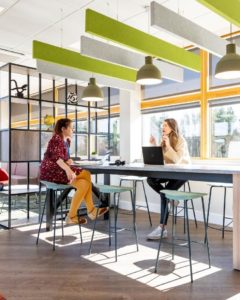It couldn’t be a more exciting time for office-based work and workplace and let’s hope by the end of 2023 we can see a clearer way forward.
Scottish Futures Trust, New Frontiers for Smarter Working – 2023 and Beyond, March 2023
Many of us had imagined we’d have more certainty in our lives, almost three years after the pandemic, but you’ll likely agree this hasn’t entirely been the case. In our recent client survey on hybrid working, we aimed to get the lay of the land and to understand the post-pandemic workplace.
Although there were no definitive answers, and ‘uncertainty’ still seems to be the word of the day, several repeated themes did emerge: recruitment and retention; attendance; space allocation and community. These concerns are dominating the workplace discourse, and it’s in our collective interest to keep a watchful eye. Below, we’ve summarised some key takeaways from the report under each theme.
Recruitment / Retention
The pandemic has undoubtedly changed the power balance between employee and employer. While, in the past, employers usually had the upper hand, these days, more employees are making their voices heard. With the increase in opportunities as a result of digital and hybrid working, employees have greater expectations from work and less hesitation in calling for change where it’s needed.
Perhaps with the aim of offering more opportunities for dialogue, and in the interest of ever-more crucial employee retention, lockdown saw a massive spike in employee surveys. Our findings showed that many organisations still carry these out (which is good) but that some don’t report the findings back (which is bad). We know from working with clients who have engaged and then not acted that this is a shortcut to disengagement and disenchantment. This is certainly something to consider going forward.
Attendance
“We’re not going back” can mean so many things. Monday to Friday, 9–5, sitting at the same desk was what we all did —nominally. Except, that wasn’t always the case for many of us. We attended meetings, went on holiday, visited clients. Still, it was our desk and we knew it and so did everyone else. Work took place in work.
Our results show that this is no longer the case (thankfully) as, for many of us, work can take place at home, on the train, and yes, in the office. There are benefits to being in the office— socially for one thing, but also in terms of information exchange and knowledge sharing. We all know colleagues who prefer to work from home and not to come into the office. It’s a leadership call on what attendance model works for your team.
Space Allocation
Our survey results are telling us that many employers don’t want to push people back to the office, they want the office to draw them back in. That means providing workplaces and technology that support the way they want to work and socialise. Rows of empty desks will not encourage attendance. A mix of spaces that support focus, that enable connection and collaboration and that provide a basic level of comfort are becoming an essential.
Will employers need as much space as before? That might be all about scale; a lot of dead space should be released; a small amount of unused space might be better repurposed to provide more variety. Losing 30–40% of your current space is not unknown. And as testified by recent BCO-winning projects, sustainable design and supporting staff wellbeing are the things that win awards.
Community
We learned that the best working environment doesn’t result in the best workplace community without passionate, engaged people involved. And not just the extroverts who will be front and centre at any event, but a broad spectrum of personalities. A key factor in building a community is to consider team dynamic when recruiting.
Due to the hybrid and global nature of work nowadays, your people are likely to be scattered and rarely in the same space at the same time unless you make an effort to keep them engaged. Having in-person social events is, according to our survey, a top factor in building a community. Don’t leave it to the same people to build the community—though having a formal group is seen as important—encourage greater participation across the board.
A resounding conclusion from the survey was that, although there’s no silver bullet that’ll solve all workplace issues, for better or for worse, decisions need to be made. And those decisions must be communicated properly. The workplace is entering new and exciting pastures, and these changes are going to impact the way we work globally. We may not have certainty on where we’re headed just yet. It’s in everyone’s interest to keep on top of trends and to understand what modern employees will be looking for.
You can read our Perspectives on Hybrid Working report in full here:




